
Sweden - Storstockholms Lokaltrafik SL
For a full scale picture, please click on the picture shown !
SL's normal gauge commuter trains
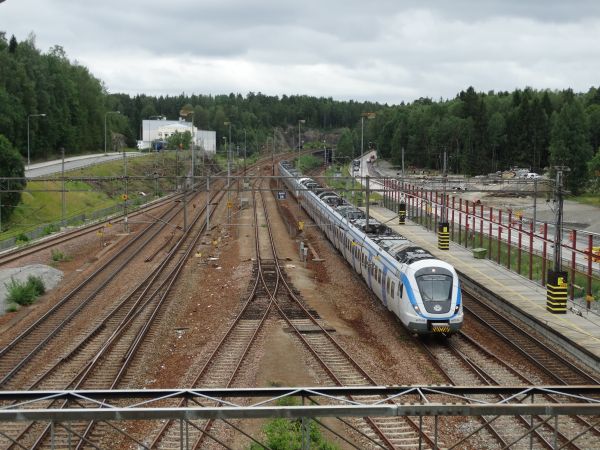
Storstockholms Lokaltrafik SL is a really big operator running buses,
trams, the Stockholm metro, commuter trains around Stockholm, a narrow gauge train network from the Stockholm East (Stockholm Östra) station
as well as some very special trains and trams such as the Lidingöbanan, the Saltsjöbanan and the Tvärbanan routes.
This picture shows two of SL's newest commuter train units of the class X60, which is an Alstom built train of the type
Coradia Nordic. As you can see, two Coradia Nordics in a row makes a really long train.
Picture from the Flemingsberg station 13.7.2016 by Ilkka Siissalo.
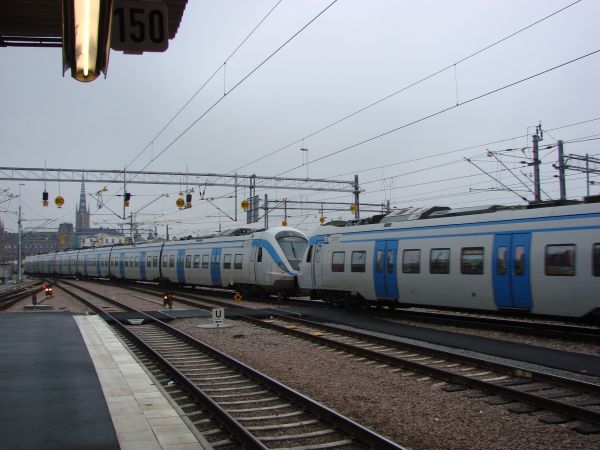
This was the time when the Alstom built Coradia Nordic trains of the class X60 were brand new. A local commuter train composed of two X60 sets
is leaving the Stockholm central station 7.11.2009. Picture by Ilkka Siissalo.
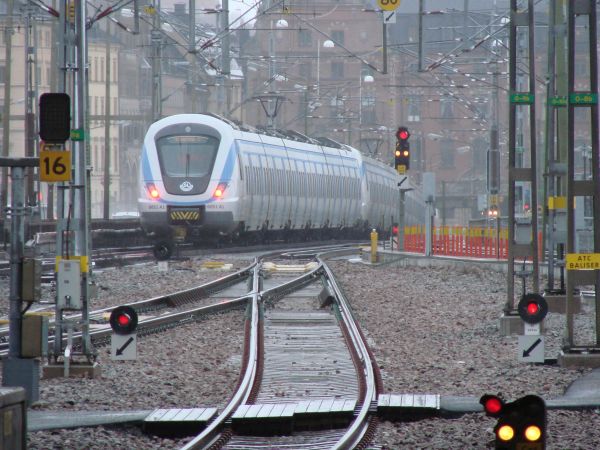
Another view of two Coradia Nordic X60 series trains just leaving Stockholm C. The trains look immensely long even when a long zoom
causes a shortening effect in the picture.
Picture 19.1.2008 by Ilkka Siissalo.
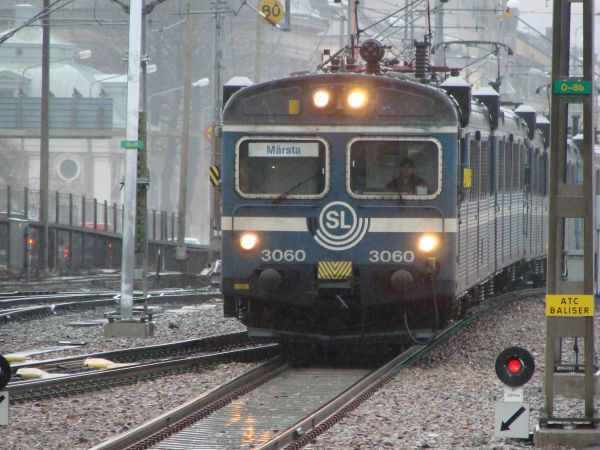
Memories from days gone by: A class X1 train approaching Stockholm central station on a snowy winter day 19.1.2008. Nowadays it is almost
impossible to find any of the X1 trains any more, because the modern Coradias of the class X60 have replaced them.
Picture from Stockholm C 19.1.2008 by Ilkka Siissalo.
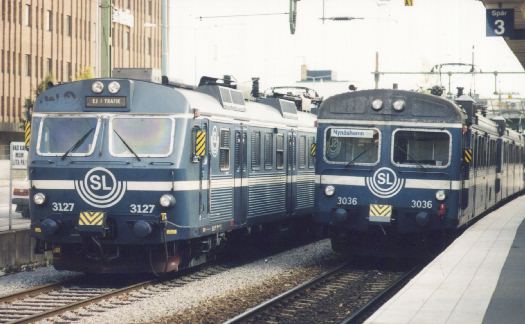
SL class X10 commuter EMU as it used to look like in the Stockholm
region; in Sundbyberg in October 1995.
Photo by Urban Fredriksson.
Uploaded Oct 18, 1995.
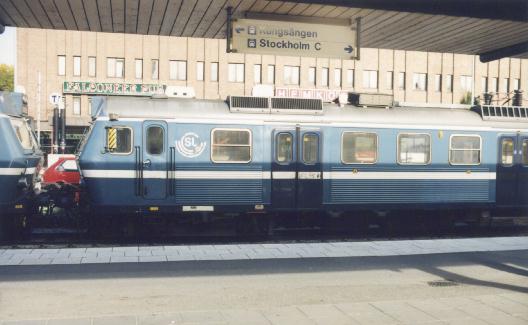
SL class X10 commuter EMU for the Stockholm area; in Sundbyberg in
October 1995.
Photo by Urban Fredriksson.
Uploaded Oct 18, 1995.
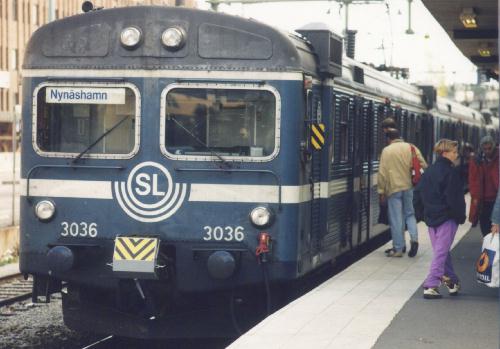
SL class X1 commuter EMU as it used to look like in the Stockholm region
in Sundbyberg, in October 1995.
Photo by Urban Fredriksson.
Uploaded Oct 18, 1995.
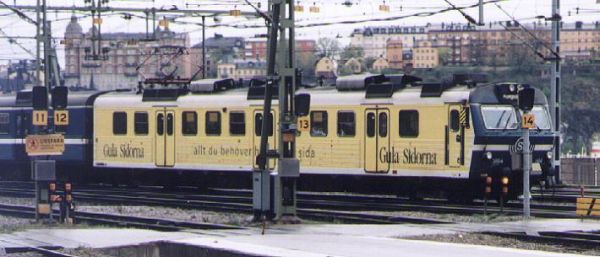
X10 3164 at Stockholm Central Station, May 1997.
It was that time the only X10 unit which was painted in advertisement
colours. "Gula Sidorna" is the "Yellow Pages" in the phone book.
The other side was white.
Photo by Urban Fredriksson.
Uploaded Jun 18, 1997.

X10 3165 at Stockholm Central Station, May 1997.
It showed the new, lighter, blue colours that the X10s and X1s around
Stockholm had since the end of the 1990s.
Photo by Urban Fredriksson.
Uploaded Jun 18, 1997.
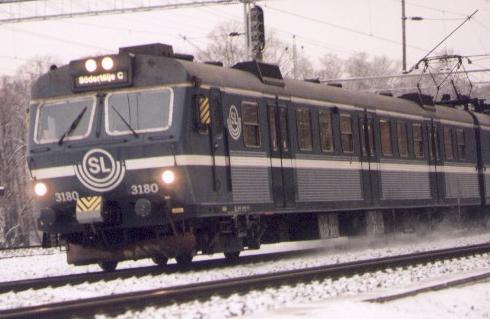
X10 3180 just north of Upplands Väsby, heading south,
January 1997.
Photo by Urban Fredriksson.
Uploaded Jun 18, 1997.

X1 3035 at Stockholm Central Station, December 1996. This and the newer X10 were in the 1990s the
two types of EMUs used in the regional commuter traffic in the Stockholm
area. Similar ones were operated in regional traffic in other areas. Photo
by Urban Fredriksson.
Uploaded Jun 18, 1997
Storstockholms Lokaltrafik SL's trams
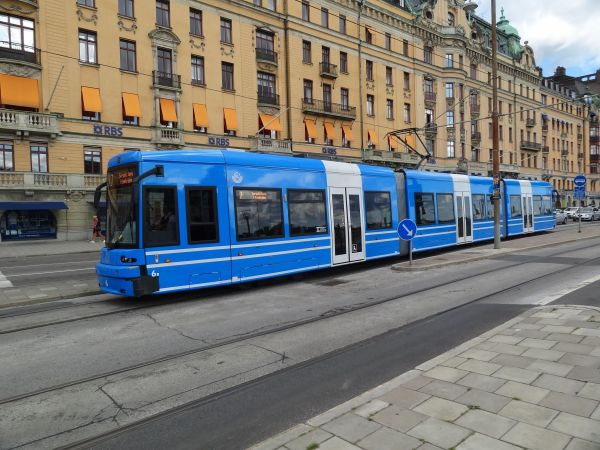
Stockholm got its first electric trams in 1901 and tram traffic kept expanding until then in 1967 Sweden
decided to change all road traffic from the English style left hand traffic to the more normal keeping to the right.
This of course meant getting rid of the old tram tracks which were by then on the wrong side of the street. One line
with modified historic trams was kept however, and based on this line no 7. a new start has been made. There is currently
still only one tram line in the city center, but there are light rail type fast trams elsewhere. The island of Lidingö
is served by Lidingöbanan, which for a long time had over 50 years old trams, but in 2015-16 got brand new bidirectional
trams from CAF in Spain. The Tvärbanan is a ring route a bit further away. There the tracks are like train tracks, but
the wagons are clearly trams. And then there is the Saltsjöbanan, which is more of a real train.
This picture is of SL tram no. 6 on line 7 at Nybrokajen in the city center 11.8.2012. Picture by Ilkka Siissalo.
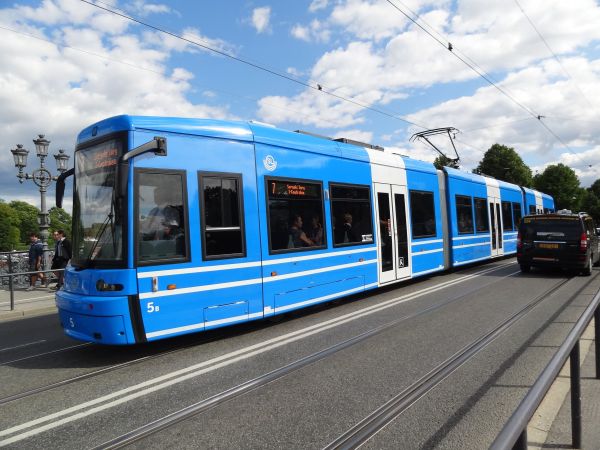
SL tram no. 5 on the Djurgårdsbron bridge 11.8.2012. This and the tram in the previous picture are trams of the type Flexity
Classic. Picture by Ilkka Siissalo.
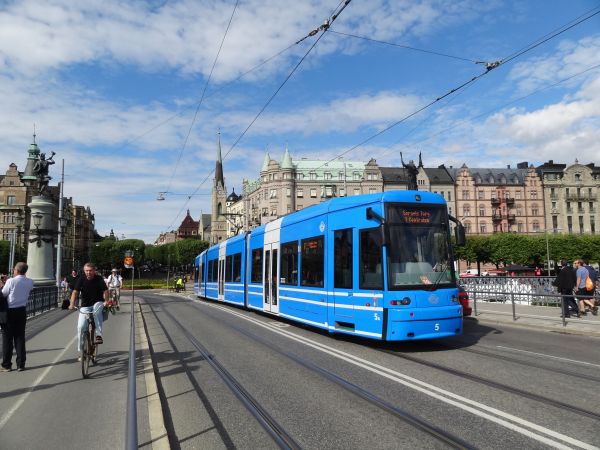
Another view of the Flexity Classic no. 5 on the Djurgårdsbron. Picture 11.8.2012 by Ilkka Siissalo.
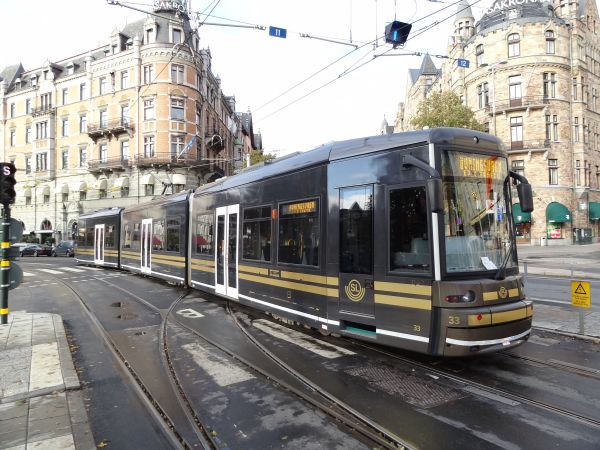
Before receiving their own new Flexity Classic trams, SL rented trams from elsewhere for test traffic on the city center line no. 7.
This one is also a Flexity Classic, but rented from the tramways of Linköping and then just taped to get an "SL look".
Picture from Nybroplan 19.10.2011 by Ilkka Siissalo.
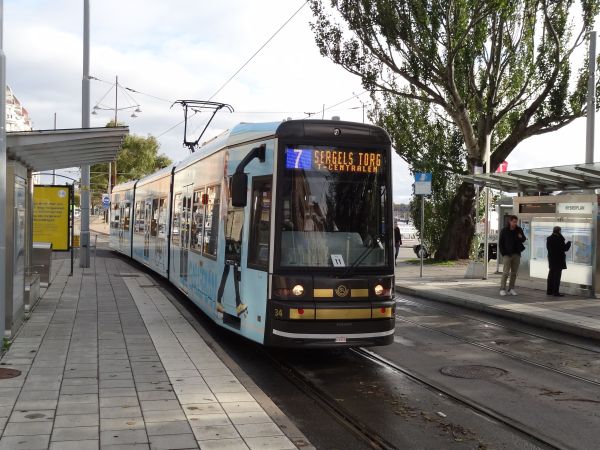
Another rented Flexity Classic at Nybroplan.
Picture 19.10.2011 by Ilkka Siissalo.
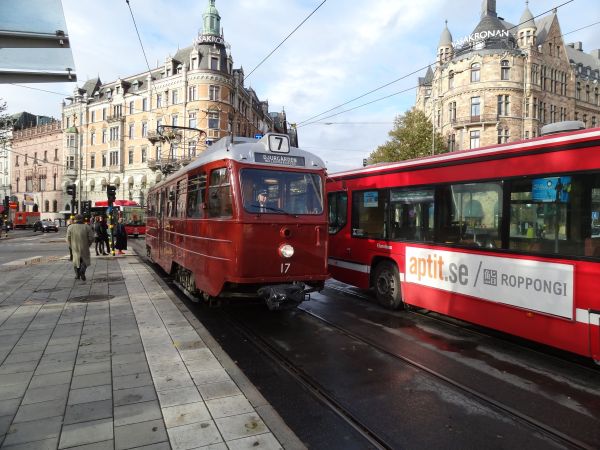
Since 1991 the fund Stiftelsen Stockholms Museispårvagnar and the society Svenska Spårvägssälskapet have been keeping a live museum tram traffic
on the line 7B, Djurgårdslinjen, with historic trams not only from Stockholm but also from other cities. This one is a so called Ängbyvagn, class
(littera) A24B which were for a very long time used at the Lidingöbanan. It is built by Asea in 1949.
Picture from Nybroplan 19.10.2011 by Ilkka Siissalo.
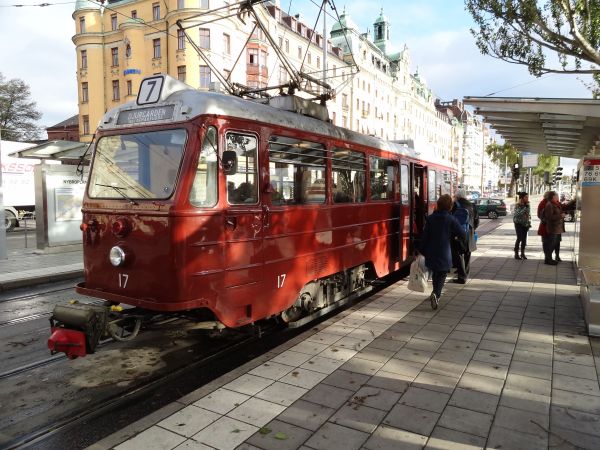
Another view of the same museum tram no. 17 at Strandvägen by the Nybroplan.
Picture 19.10.2011 by Ilkka Siissalo.
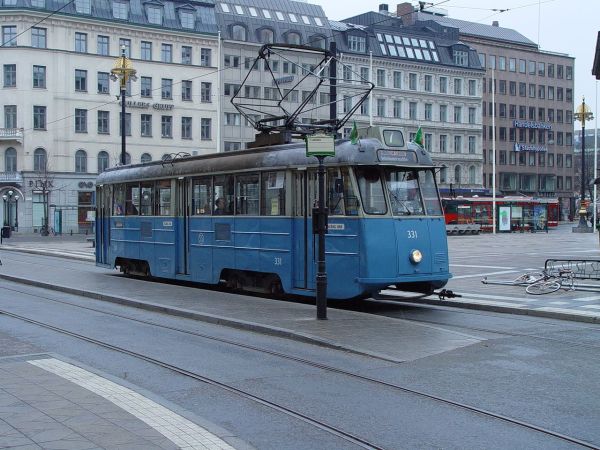
Another museum tram on the museum line 7B. This one is a so called Mustang wagon built by Hägglunds in 1947.
Picture close to Sergels torg 27.4.2003 by Ilkka Siissalo.
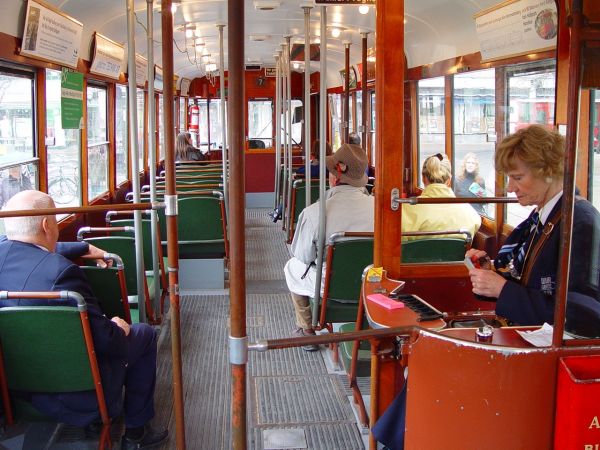
Same museum tram as above. It's hard to believe this picture was taken in 2003 and not in the 1960s.
Picture close to Sergels torg 27.4.2003 by Ilkka Siissalo.
Roslagsbanan
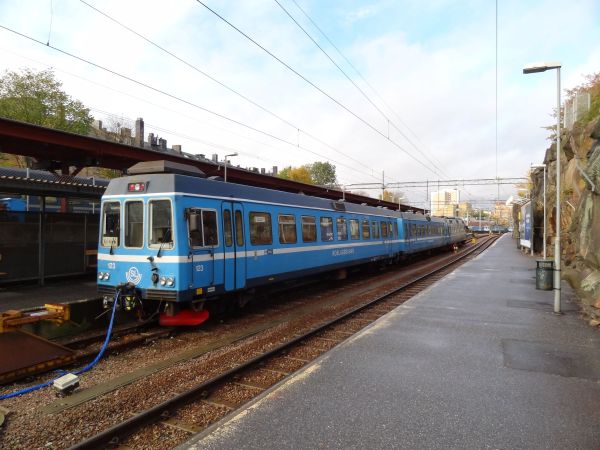
Roslagsbanan is a narrow gauge railway system operated by SL from the Stockholm Östra station. It has a somewhat exotic gauge: 891 mm
and it uses 1500V DC current just like typical trams do. It has 3 branches and operates to the north and to the east of Stockholm.
Since 2013 the operator has been Arriva Sverige on behalf of SL. Presently all the trains are similar and they were built by ABB
in 1988-1995. The motorised coach is called littera (type) X10p. However, new trains are already on order from the company Stadler.
A typical Roslagsbanan train is composed of one motorised coach, one middle coach and a steering wagon.
Picture by the Stockholm Östra station 19.10.2011 by Ilkka Siissalo.
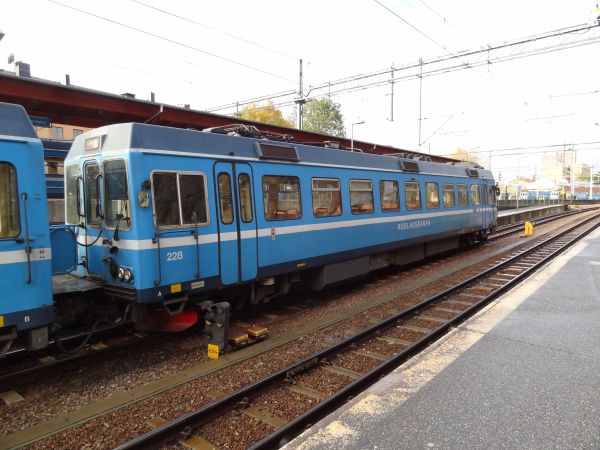
A Roslagsbanan motor coach of the type X10p.
Picture by the Stockholm Östra station 19.10.2011 by Ilkka Siissalo.
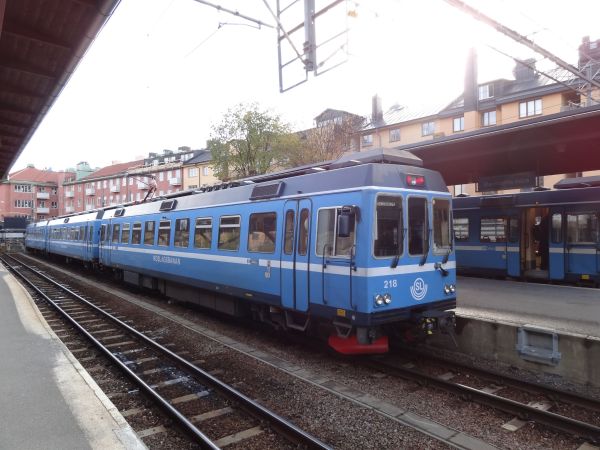
Another Roslagsbanan train.
Picture from the Stockholm Östra station 19.10.2011 by Ilkka Siissalo.
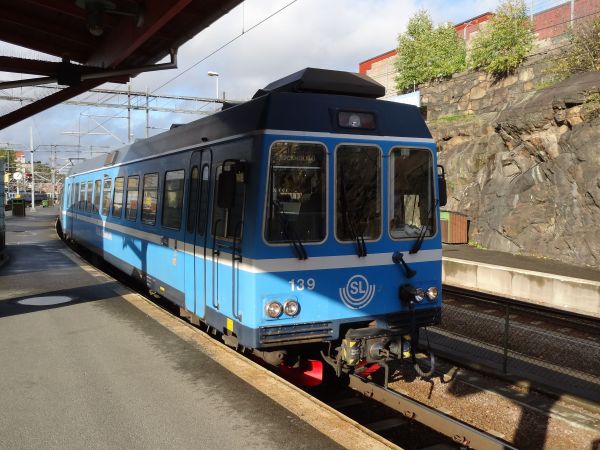
A Roslagsbanan motorless steering wagon.
Picture from the Stockholm Östra station 19.10.2011 by Ilkka Siissalo.
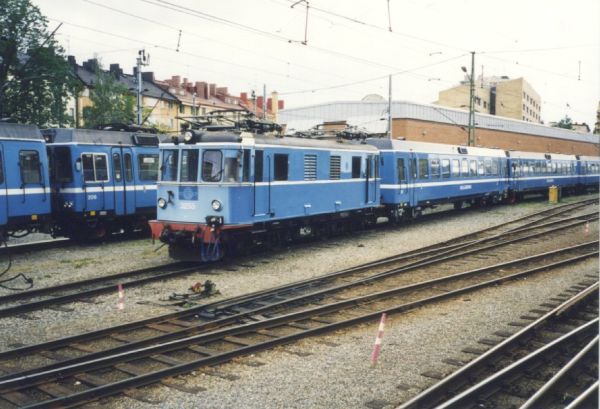
This is something that you are not likely to see anymore: a locomotive running a passenger train at Roslagsbanan.
Storstockholms Lokaltrafik (SL) Roslagsbanan, 891 mm gauge locomotive class Bdp at Östra Station in Stockholm.
Photo by Marco van Uden.
Uploaded Nov 29, 1995.
Lidingöbanan

Lidingöbanan serves the island of Lidingö. The line starts from Ropsten metro station, then crosses a huge bridge over to Lidingö
and then finally splits into two branches, the main line being between Ropsten and Gåshaga brygga. It is marked as line 21. The line is normal
gauge 1435 mm and it is 9,2 km long. There are plans to connect the Lidingö line and the city center tram line no 7. to provide one single service.
A brand new CAF tram crossing the huge bridge system from Ropsten to the island of Lidingö. Picture 13.7.2016 by Ilkka Siissalo.

A brand new CAF Urbos AXL tram no. 552 just after crossing the bridge from Ropsten. It has arrived to Lidingö and will soon stop at the first
tram stop called Torsvik in the Herserud part of Lidingö.
Picture 13.7.2016 by Ilkka Siissalo.
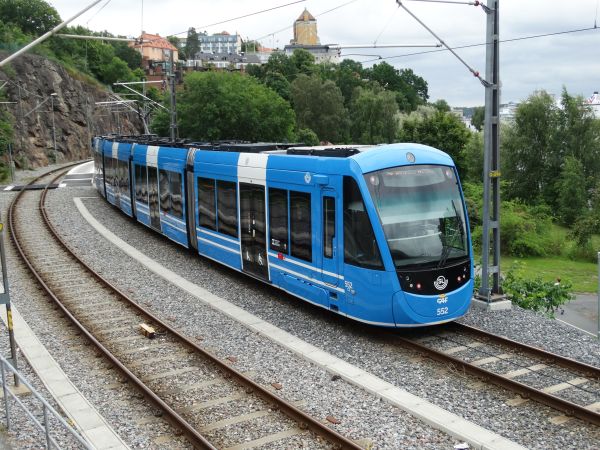
Another view of the same CAF tram as in the picture above.
Picture from Lidingö 13.7.2016 by Ilkka Siissalo.
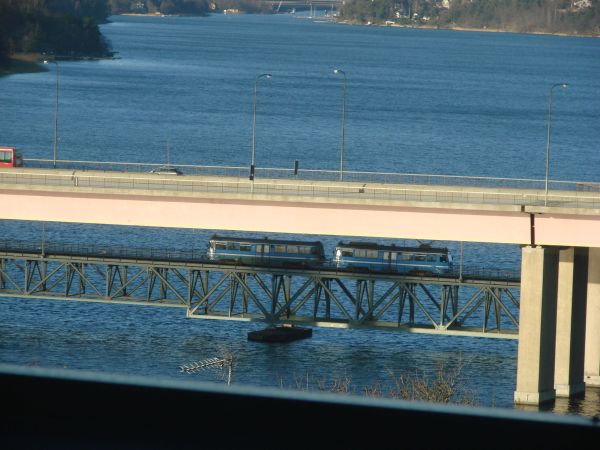
This is how the well over 50 years old previous Lidingöbanan trams used to look like after all the modifications. The picture is taken from
far away through a hotel window with a powerful zoom and it shows the old train on the bridge between Ropsten and the island of Lidingö.
Picture 20.1.2008 by Ilkka Siissalo.
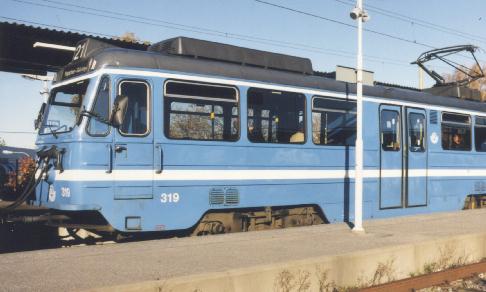
Lidingö tram of type A30B. SL A30B 319 at Ropsten, Oct 29, 1995.
Photo by Urban Fredriksson.
Uploaded Nov 17, 1995.
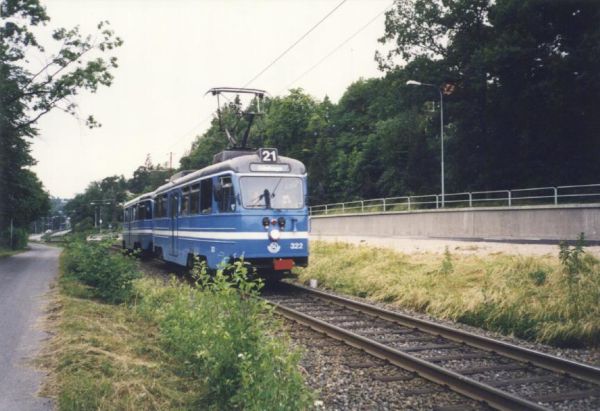
SL tram belonging to Lidingöbanan.
Photo by Marco van Uden.
Uploaded Nov 29, 1995.
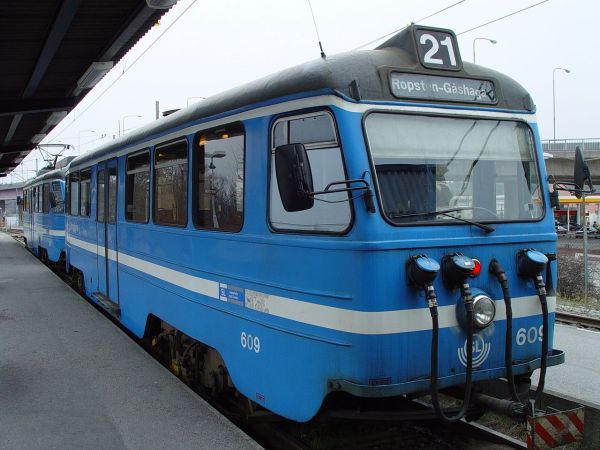
This is history by now: The over 50 years old Lidingöbanan trains in 2003. After all the modifications it was hard to say if these should
have been called trams or trains.
Picture from Ropsten station 27.4.2003 by Ilkka Siissalo.
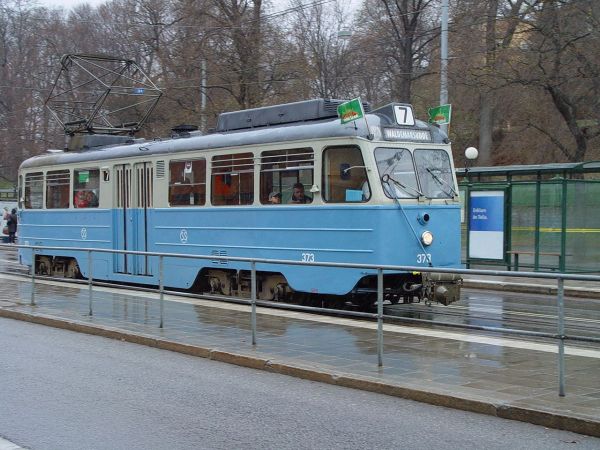
This museum tram is seen here on the museum tram line 7B near Djurgården, but this is a tram built for the Lidingöbanan by Asea in 1944
and it shows how the trams used to look like before all the modifications and modernisations. Compare with the previous picture.
Photo from Djurgården 27.4.2003 by Ilkka Siissalo.
Saltsjöbanan
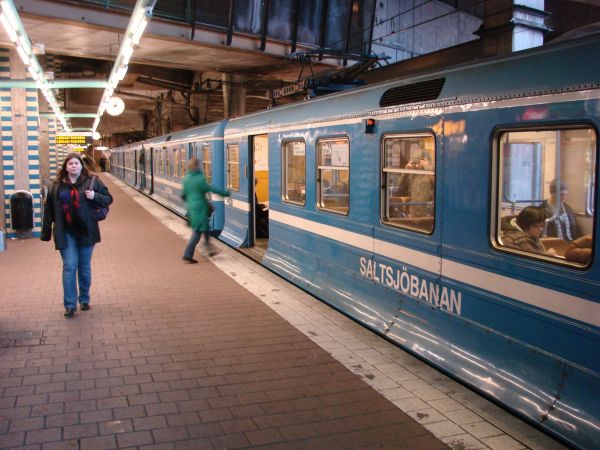
Saltsjöbanan (salty sea train) starts from the Slussen metro station close to the old town of Stockholm and leads south to Saltsjöbaden
(salty sea bathing place) in Nacka in around 19km long line. It is normal gauge 1435mm and operates with 750V DC. The trains still used today
are of the classes C10 and C11, which are old used metro trains of the class C8 but modified to take electricity using a pantograph from above.
New trains are expected to arrive soon.
A typical Saltsjöbanan train ready to leave from the Slussen station. Notice how this old ex-metro train has received funny metal "bumps"
at its sides to prevent stupid passengers from falling from the platforms into the gap between the train and the platform. The lady walking towards
the camera is train photographer Sanna Siissalo.
Photo at Slussen station 13.12.2008 by Ilkka Siissalo.

A Saltsjöbanan train ready to leave. Notice how the train has been modified from an old metro train.
Photo at Slussen station 13.12.2008 by Ilkka Siissalo.
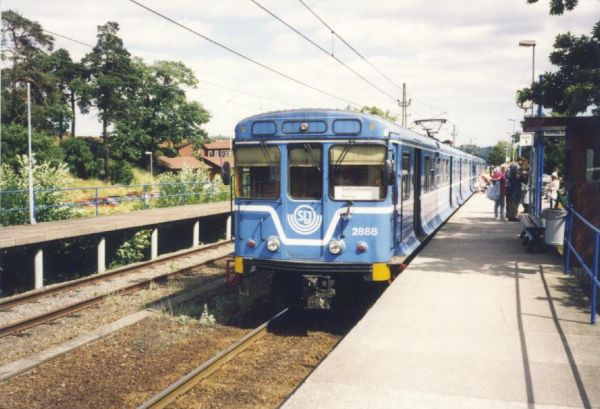
Storstockholms Lokaltrafik (SL) train of class C10 on
Saltsjöbanan at the end station Saltsjöbaden.
Photo by Marco van Uden.
Uploaded Nov 29, 1995.
Stockholm's metro, Tunnelbanan
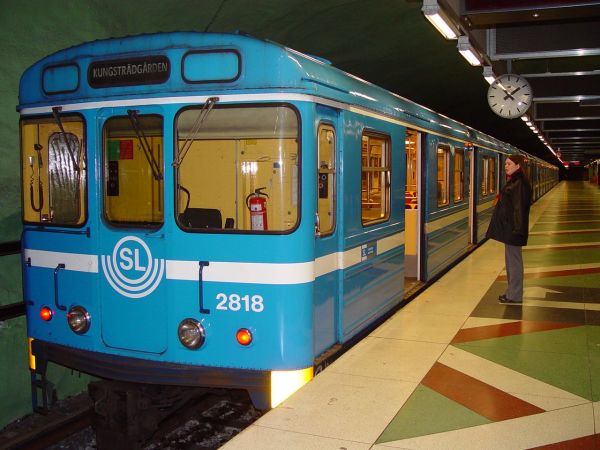
One of the old C8 trains of the so called blue line at the Kungsträdgården station. These trains have been long ago replaced by now,
but look at the resemblance with the Saltsjöbanan line's train above.
Picture 26.4.2003 by Ilkka Siissalo.

This is how most of the Stockhom Tunnelbanan trains look like today, but even newer trains will arrive soon. This is a class
C20 train built by ADtranz 1997-2004.
Picture by the Ropsten station 27.4.2003 by Ilkka Siissalo.

Busy service in the Tunnelbanan as three C20 units pour out their passengers. Picture 27.4.2003 by Ilkka Siissalo.
Tvärbanan
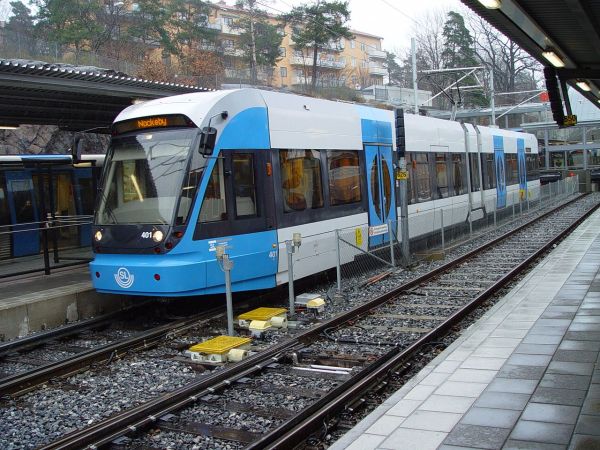
Tvärbanan, in English Cross railroad, also known as Nockebybanan, is a light rail system, which in most places operates like a train
but in certain places goes to streets and runs like a tram. The long line runs around the whole city center from Sickla in the southeast
to Solna in the north cruising around the city in a clockwise direction. The trams used are Flexity Swift trams, known in Stockholm
as class A32. Newer trams have been ordered from CAF in Spain and these will then be the class C35.
A Flexity Swift of the Tvärbanan. Picture at Gullmarsplan 27.4.2003 by Ilkka Siissalo.

Another Flexity Swift of the Tvärbanan.
Picture at Gullmarsplan 27.4.2003 by Ilkka Siissalo.
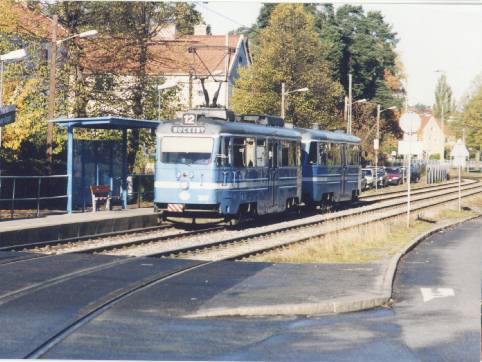
This is what the old Nockebybanan trams used to look like. Stockholm tram SL class A30 307 at Klövervägen, Oct 29, 1995.
Photo by Urban Fredriksson.
Uploaded Nov 17, 1995.
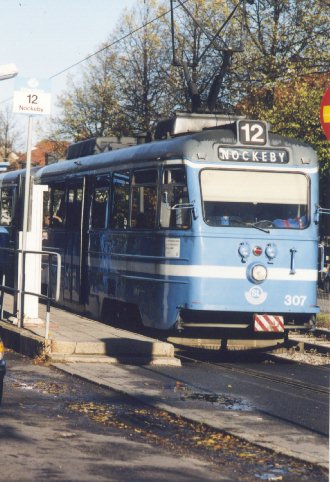
Another old picture of a Stockholm tram, SL class A30 307 at Klövervägen, Oct 29, 1995.
Photo by Urban Fredriksson.
Uploaded Nov 17, 1995.
Tram museum

An old tram at the Swedish Tram Museum in Malmslätt in 1994.
Photo by Urban Fredriksson.
Uploaded Oct 18, 1995.

